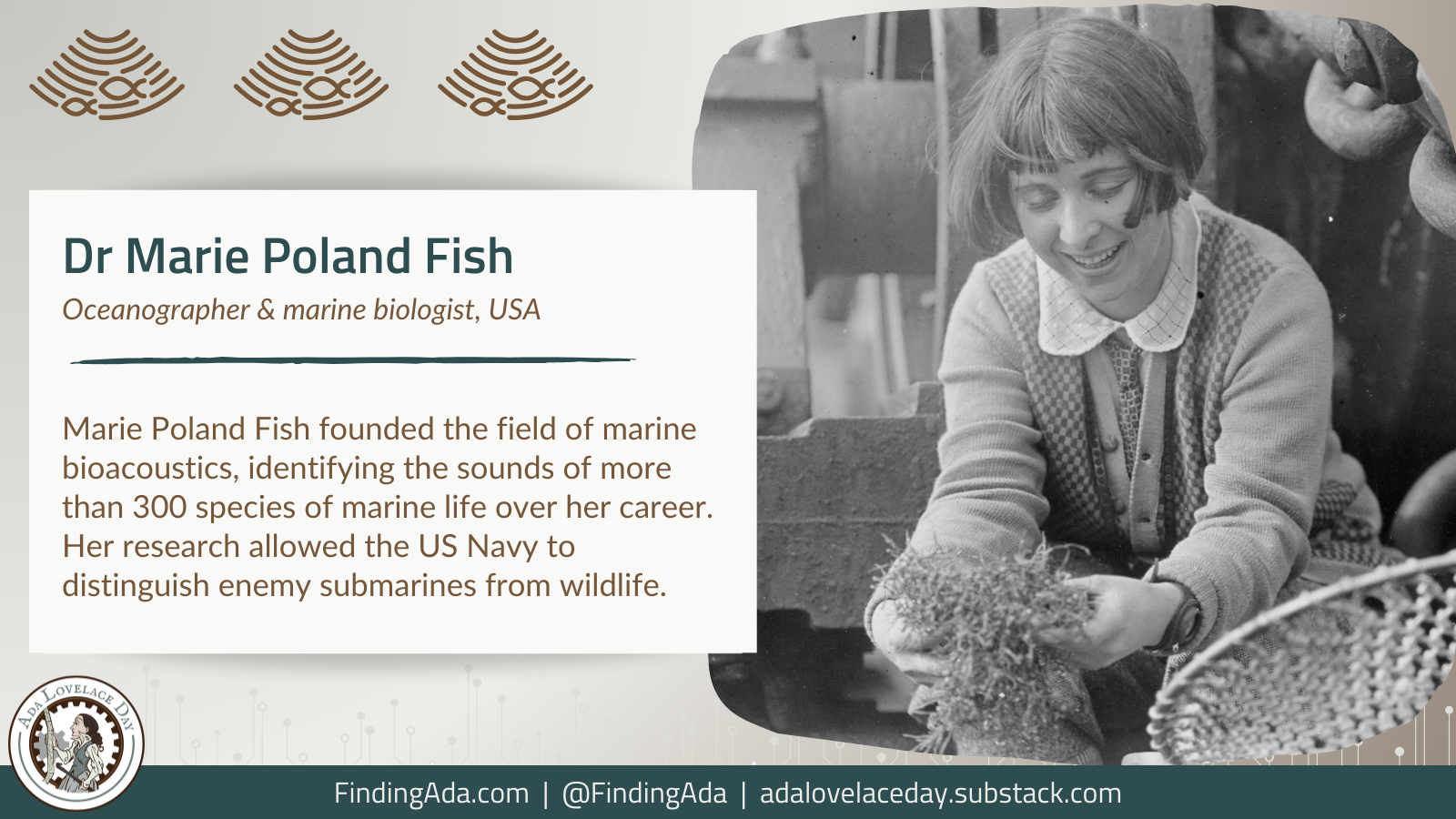Dr Marie Poland Fish
Dr Marie “Bobbie” Dennis Poland Fish was an American oceanographer and marine biologist who founded the field of marine bioacoustics (the study of how marine wildlife uses and produces sound). Her pioneering research saw her record and analyse the sounds of hundreds of species of marine life, enabling the United States Navy to distinguish between enemy vessels and underwater creatures.
Fish was born Marie Poland in Paterson, New Jersey in 1900. She graduated from Smith College in 1921, later receiving a PhD in science from the University of Rhode Island. In 1923, after spending a year as research assistant to the plankton scientist (and her soon-to-be husband) Charles Fish, she was hired to study fish eggs and larvae for the U.S. Bureau of Fisheries.
In February 1925, Fish left the US for a six-month oceanographic expedition through the Sargasso Sea to the Galápagos Islands. During this trip, she became the first person to identify the eggs of the elusive American eel by carefully collecting them and watching them develop. Her discovery, she wrote later, revealed “the last secret concerning the life history of the American eel which [the sea had] jealously guarded for so many centuries”.
Fish worked in ichthyology (fish biology) at various institutions from the late 1920s and throughout the 1930s. These included the Conservation Department of New York and the U.S. National Museum, now the Smithsonian National Museum of Natural History. In 1936, she and her husband established a marine lab at the University of Rhode Island, which still exists as the university’s Graduate School of Oceanography. Such was her renown as a marine biologist that when the US Navy needed help with a long-standing mystery, it was Fish they contacted.
Since the start of World War II, submarine crews and sonar operators in the Navy had been perplexed by strange underwater sounds, from rumbling and beeping to hammering, clanging and clicking. These sounds were sometimes so loud they threatened to detonate mines and sink ships. The Navy suspected that marine life, rather than enemy submarines, could be behind them – and once the war was over in 1946, Fish was brought on to investigate.
She got to work cataloguing the sounds heard by Navy officers, then launched experiments from her base at the University of Rhode Island. Using techniques including lowering hydrophones into Narragansett Bay, she was able to match previously mysterious noises with the sea life that created them. By 1954, Fish had identified the sounds of more than 180 species through what she called her “underwater detective agency”, both in Rhode Island and via expeditions to the Bahamas, the Virgin Islands and Puerto Rico. She had built up a huge acoustic library on recording discs, which the Navy used to train sonar operators to tell the difference between hostile subs or boats and marine life.
Fish was also sent to Europe to train allied Navy operators in France, England and Germany. In addition, her work explored how underwater wildlife makes sound; before the process was formally described, she had correctly hypothesised that whales communicate via echolocation.
Fish died on 2 February 1989 at the age of 88, having written over 200 articles in academic journals and popular magazines and recorded and analysed the sounds of more than 300 species of marine life. She received the United States Navy’s highest civilian award, the Distinguished Service Medal, in 1966.
Further Reading
- Bertha Parker Pallan, Wikipedia
- Marie Fish, 88, Dies; Navy Oceanographer, The New York Times, 2 February 1989
- Bertha “Birdie” Parker, Suzie Birch, Trowelblazers, 8 May 2014
- Bertha Parker, the trailblazing first Indigenous North American archaeologist, taught herself how to excavate a site, Ashley Marranzino, Massive Science, 6 June 2019
Written by Moya Crockett, with thanks to Stylist for their support.
